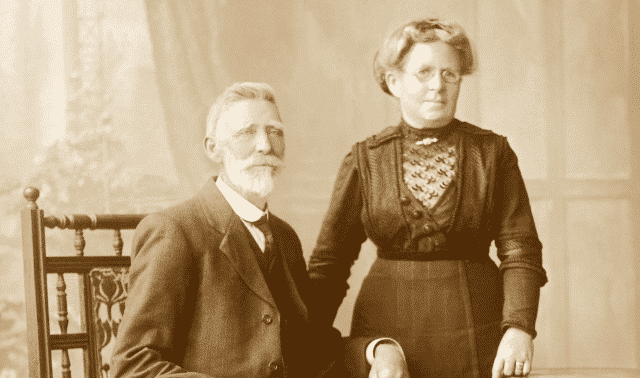Sign up for the Family Tree Newsletter Plus, you’ll receive our 10 Essential Genealogy Research Forms PDF as a special thank you!
Get Your Free Genealogy Forms
"*" indicates required fields

If you’re like me, as each new year settles in, you fill the blank pages of your calendar quickly—too quickly. But this year, elevate your family history research to a priority worthy of its own spot in your schedule. Whether you mark off 15 minutes a day, an hour a week, or a weekend binge every month is up to you.
Not sure what to do in that time? Too busy to think about next month, let alone six months from now? We hear you, and we’re here to help.
Here’s your guide to planning an orderly, comprehensive and time-flexible series of essential family history tasks for the coming year. And we’ve broken each goal into several achievable steps. Choose one task each month if your time is short, or go all-out and try several. Re-order the monthly assignments as needed to fit your schedule, lifestyle and budget. The important thing is to keep your genealogy calendar time slot full of family history tasks you love (or need) to do.
ADVERTISEMENT
Jump to:
January
February
March
April
May
June
July
August
September
October
November
December

JANUARY | Get Organized
Start the year off right by organizing what you’ve already learned about your family. In addition to having an organized workspace, organizing the research you’ve already done prevents you from repeating your efforts.
Check out our free, downloadable forms and charts for some additional organization help!
ADVERTISEMENT
Set up computer file folders. Create a genealogy file on your computer (if you don’t already have one). Add subfiles for each surname you’re researching. As you add new surnames, you could add folders at the same organizational level (Plan A) or nest them within major surnames of interest (Plan B). Plan A is simpler; Plan B mimics your family structure.
Within each surname folder, add subfolders for nuclear family groups as needed. This will be especially helpful if you’re studying multiple generations of a family. (If you’ve already got an electronic family history filing system, tidy it up.)
Populate subfolders with files. Add digitized photos and documents, research reports and other materials relating to each person or family group. Download copies of records attached to ancestors in your online trees, which ensures you’ll have copies of the files even if your subscription expires or the site goes down.
Download raw DNA data. Do this for all tests you manage. Stash your raw data in a DNA subfolder in your main genealogy file. Read instructions for downloading data from AncestryDNA.
Start (or update) your family tree online or in genealogy software. Be sure all your discoveries get added to the appropriate individuals. If your tree “lives” in software on your computer, activate any syncing features so linked online trees stay current.
This protects you against computer failure or other loss. You could do regular, manual backups to multiple locations (cloud-based storage such as Dropbox and hardware-based using an external hard drive). Automate this process—and make it continuous—by using a cloud-based backup system such as Backblaze, Carbonite or iDrive.
Take your level of organization up a notch with Drew Smith’s Organize Your Genealogy guidebook.

FEBRUARY | Reconstruct a Family
Cold-weather weekends are great for research binge sessions. This month, you’ll use records to reconstruct a family. This is a perfect next step after organizing what you already know, and can rapidly expand your genealogy knowledge.
Identify a family or branch on your tree for which you have little information.
Put a working family tree on genealogy websites you subscribe to. This activates automated record hinting, which means you’ll get hints and links to censuses and vital records that may match your ancestors.
Carefully review record hints for each nuclear family, beginning with the most-recent generations. Watching for records that match on multiple, specific parameters, such as a spouse’s name and the names and approximate ages of children. Attach records to their tree profiles only when you have a high degree of confidence in the match—but keep track of “maybes” for later reference.
Go to each family member’s tree profile after exhausting record hints. Look for record gaps such as missing census years or dates of birth, marriage or death. Run targeted searches for records likely to fill these gaps. Identify as many records about the same vital event as possible (for example, an obituary, death certificate and tombstone inscription). Multiple, independent sources for these vital events strengthen your tree.
Clean up loose ends as you go. For example, if you find a second marriage, determine how the first one ended. Try to identify which children belonged to each partner and ensure the relationships are correct on your tree (record hinting systems may automatically attach children to step-parents when they appear together in records).
Identify other sources. As needed, visit different genealogy websites or research specific record types to learn about records covering your ancestor’s time and place, and how you can get them.

MARCH | Find Female Ancestors
Observe Women’s History Month by paying extra attention to your female forbears. In the past, women appeared in records with far less frequency than men, and even less often under their own names (a woman might be “Mrs. Charles Smith” instead of Fannie Jones). That’s why you may have so many “dangling women” on your tree, for whom you have only a birth year.
Focus on one or two female ancestors. Dig into the records of husbands, siblings (especially brothers), parents and children. Look for maiden surnames in relatives’ obituaries. See whether marriage records (especially for a first marriage) and children’s birth records mention her maiden name. In older records, look for marriage bonds or a woman’s appearance as a widow in her husband’s military pension files.
Take a mitochondrial DNA test, available from Family Tree DNA to more deeply explore your maternal lineage. If you test early enough in March, you’ll likely have your results by Mother’s Day (the test takes about six to eight weeks to process).
Both men and women carry their mothers’ mtDNA, but only women pass mtDNA on to their children. An mtDNA test traces your maternal line’s deep ethnic origins. You’ll get an idea where in the world your direct maternal line (mother’s mother’s mother) is on this maternal line. You also may benefit by reviewing mtDNA matches. Just keep in mind that the testing pool is small and mtDNA rarely mutates, so you won’t be able to tell how closely related you are to your matches.

APRIL | Do More with DNA
April 25 is National DNA Day—a great time to order DNA tests on sale—for yourself and for relatives. Start with autosomal DNA testing, offered by AncestryDNA, MyHeritageDNA and 23andMe. This can identify matches on both sides of the tester’s family who have a common ancestor four to six generations in the past. Y-DNA tests, which follow your direct paternal line (father’s father’s father, etc.), are useful for finding cousins with shared ancestors along your paternal line.
Ask relatives to test. Their DNA may help you solve family history mysteries. A person who’s not interested in testing for genealogy research may still be dying to learn his ethnicity breakdown. Respectfully address any privacy concerns and maintain confidentiality when relatives test. Though you may have access to their results, it’s their DNA to share (or not) as they wish.
Message matches. If you’ve already tested, work to learn your relationship with your closest DNA matches by contacting them through the testing site to compare family trees. Search for common names and places of birth. Also examine your shared matches (see Diahan Southard’s article on how to analyze matches using triangulation). Log what you learn in a spreadsheet or in the notes field for each match.
Use new tools. Upload your raw DNA data to collaborative genetic genealogy websites such as GEDmatch to find additional matches and use analysis tools. Also consider uploading your DNA data to testing company websites that accept uploads (currently, they’re MyHeritage DNA, Living DNA and Family Tree DNA).
Explore health insights. Take 23andMe’s Health + Ancestry test or upload your raw DNA data to an inexpensive service such as Promethease or Livewello. Share the results with your doctor—remember that these tests don’t have diagnostic power.
Join a DNA study focused on a surname, haplogroup, ethnicity or geographic origin. Check Family Tree DNA and Cyndi’s List.
When doing DNA research, be prepared for unanticipated discoveries. Communicate tactfully with matches, especially concerning previously unknown relationships. If you think you’ve discovered information that may affect living relatives, you might consult a professional genetic genealogist to confirm your results. Then consider carefully whether and how to share what you’ve learned.

MAY | Do a House History
This month, take time to learn the history of your own home or another building significant to your family history. You may be able to learn the original layout of a property, when it was built or remodeled, how much your family paid, and who else has lived there. If you’re so inclined, compile a binder with your own house history and leave a copy as a gift for the next owner—this might even influence potential buyers looking for a special new home.
Start online. The county clerk’s or recorder’s website might have an online real-estate database you can search by address for clues to when the structure was built, its lot number and sales history.
Trace property transfers through deeds. If you can go to the local courthouse or a library with microfilmed deeds (or if you’re lucky enough to find county records digitized at FamilySearch), research ownership history by finding the most recent deed and using it to identify the previous owner and deed. Then look at that deed and then the previous one, and so forth. This is called following a chain of title, and it may take you back to the original owner. Those documents may hold a property description and other interesting tidbits.
Look for old maps. You also might find plat maps or other maps from the time your ancestors lived there on sites such as the David Rumsey Historical Map Collection. Fire insurance map collections such as Sanborn Maps, many of which are available on the Library of Congress website may reveal details such as construction materials, uses (such as “store” or “bakery”) and what the neighborhood looked like at the time.
Document residents in records. Research who lived in the house in city directories and censuses. You can search for the address as a keyword in digitized city directories on sites such as Ancestry and MyHeritage. Then search for the residents’ names in US census records.
You can find links to city directories (some, free) at the Online Historical Directories Website.
Check out news that happened nearby. Search for the property’s address and residents’ names in digitized newspapers on sites such as Newspapers.com and GenealogyBank.

JUNE | Go Outside
As summer kicks off, set down your laptop and head outside. If possible, go visit those ancestral stomping grounds you learned about last month.
Stroll through old family neighborhoods. Go looking for landmarks that may have been around during your relatives’ day: homes, churches, monuments and even trees. Try to spot the oldest buildings and imagine the spaces between them before they were filled. If you have family addresses from old records, try to locate the address as it exists today. Is the home still there? How has the neighborhood changed?
Visit relatives’ graves. A trip to local cemeteries could turn up relatives. Study graves for genealogical clues: birth and death dates, and extended family burials nearby. Take photos of inscriptions and clustered graves. (Gravestone rubbings are illegal in many place. Unless you have express permission from cemetery staff, just take pictures.) If graves look like someone’s actively caring for them you may have a heritage-minded cousin living nearby.
Stop at the library. Your family’s hometown library could be a unique resource for neighborhood maps, old school yearbooks and local histories.
Let Google Earth show you around if you can’t leave town. Enter an address or approximate location in Google Earth. Where available, use Street View to surround yourself with a 360-degree view of the neighborhood. Cemetery websites such as Find A Grave or BillionGraves can help you locate and even virtually tour your relatives’ final resting places.

JULY | Reconnect with Relatives
Summertime often means family reunions; a chance to catch up with distant cousins. You also might have a bit more leisure time to plan get-togethers.
Take the lead. If you’re hosting a reunion, bless you. If you’re attending, offer to help with something, such as managing door prizes, handling the event invite on Facebook, bringing desserts or creating a heritage display.
Schedule time with relatives. There’s no need for grand plans. Have dinner with a favorite aunt, go on a walk with your cousin, invite the kids for a pool party or plan a siblings’ getaway weekend.
Ask about family history. Oral history interviews strengthen relationships and benefit your family history research with firsthand knowledge. You could sit down with Great-aunt Marie at a reunion or schedule a separate time. Let her know ahead of time what you’d like to talk about: her own life stories, memories of older relatives or her cache of family artifacts. Ask if you can scan her old family photos, and if you can record the conversation (smartphone apps make it easy).
Use technology. If you can’t meet in person (or you want to keep in touch after the reunion), bridge the distance via Skype, telephone, a personal email or an old-fashioned letter. Share a favorite memory of the person and say what you appreciate about him. You also could send a copy of a favorite family photo or invite the person to view your online family tree.

AUGUST | Travel Into History
Incorporate your love of heritage into summer road trips before the season fades away. The genealogist’s ultimate destination is often a research library, such as the FamilySearch Library in Salt Lake City or the Genealogy Center at the Allen County Public Library in Fort Wayne, Ind. Also investigate state archives and local libraries where your ancestors lived.
Prepare for a library trip. Before you start your library research, identify questions you hope to answer and which library resources can help. Find out about hours, parking, copying materials and other logistics. If you want to use any rare or manuscript items, call to confirm they’ll be available for your use.
Tour a living history destination. This is a great activity, particularly if you’ll have traveling companions. History destinations immerse visitors in the sights, sounds, smells and tastes of the past. You might be able to watch costumed artisans bake bread on a hearth or hammer on a blacksmith’s anvil. Or, perhaps you can ride in a horse-drawn carriage, canal boat, Model T car or narrow gauge rail car. Find a museum related to your family’s history on the ALHFAM website (The Association for Living History, Farm and Agricultural Museums).
Looking for a simpler way to travel into the past? Curl up in a hammock or on the beach with a good historical novel. Well-researched and written books can transport you to another time and place.

SEPTEMBER | Improve Your Skills
Take yourself back to school this month. What new genealogical skill would you like to learn or brush up on? Consider these options:
Drop into the meeting of a local genealogical or historical society. Search online for such groups by using the name of your city or county and the phrase genealogical society or historical society, look for notices at the local library, or see the NGS website (National Genealogical Society). You may meet kindred spirits, find out about classes, and discover opportunities to help your community preserve its history. Be prepared to pay a minimal fee to visit or join the group.
Take an online class. Hone a skill you need to move your family history research to the next level with a class. For example: using Y-DNA test results, searching genealogy websites more effectively, or reading old German records. Check out offerings for topics you have in mind at Family Tree University.
Listen to a podcast. These online “radio shows” bring you genealogy education in an entertaining, portable format. Naturally, we love the free monthly Family Tree Magazine podcast, packed with tips from our editors and contributors. This podcast is hosted by Lisa Louise Cooke, who also hosts the free Genealogy Gems Podcast. The Genealogy Guys offer two educational podcasts. Find these and others via Apple Podcasts, Google Play Music, Spotify or your favorite podcast app. Or listen from your computer by visiting the websites and clicking on a recent episode.

OCTOBER | Give Back
As you celebrate Family History Month, an unofficial observation by many genealogy organizations, take the opportunity to make family history more accessible.
Contribute tombstone photos to crowdsourced collections at Find A Grave or BillionGraves. To find a nearby cemetery at Find A Grave, look under Cemeteries > Browse by Location; at BillionGraves, go to Research > Cemetery Search. Both sites also have mobile apps. Look for cemeteries with few tombstones already listed, and follow instructions to upload gravestone photos.
Respond to others’ requests for tombstone images. You can help someone who can’t travel to a burial ground near you. At BillionGraves, log in and click Research > Photo Requests to view the requests board for cemeteries near you. At Find A Grave, go to an individual cemetery’s home page to see any photo requests.
Index or transcribe records. Ask about local indexing projects at the society you visited last month. Join the 1.2 million volunteers who transcribe digitized records via FamilySearch Indexing. Or, help indexing and transcription initiatives of the National Archives, Smithsonian, or the Holocaust Memorial Museum to name a few of the many organizations looking for volunteers.

NOVEMBER | Tell Your Stories
It’s NaNoWriMo, National Novel Writing Month. Why not write your ancestors’ stories, or even just one ancestor’s story? Create projects you can give as holiday gifts next month—you’ll thank yourself later (and so will others). And writing your ancestor’s life story gives you an opportunity to organize, analyze and put into print the family history discoveries you’ve made.
Choose an ancestor you’re excited to write about. Review your collection of documents about that person, as well as information in your tree, research logs and notes you’ve kept. (This’ll be easier if you’ve kept up with January’s organizing system!)
Gain a sense of your ancestor’s story. Create a timeline or draft a narrative of your ancestor’s life, based on the evidence from old records. Analyze conflicts in the evidence and resolve them as best you can by finding additional documents and judging which sources are more likely to be correct. Also identify gaps in the story and decide how best to handle them.
Rewrite, edit and proofread. Turning your initial timeline or draft into a ready-to-share narrative is going to take time and effort—use NaNoWriMo to your advantage. Consider joining a family history writing session at Family Tree University to guide you through this process.
Create a different kind of family story project. Try framing ancestral photos with their accompanying stories; these make cherished gifts. You also could create an album with photos of relatives, family homes, or heirlooms. Another option is a professionally printed family tree chart or a personalized map of your DNA ethnicity, such as those from Family ChartMasters.

DECEMBER | Celebrate Traditions
Take a break this month from serious ancestor hunting to enjoy time with living relatives. This doesn’t mean you have to ignore family history. In fact, it’s an ideal time to let your family heritage inspire your thoughts and activities.
Enrich seasonal celebrations with favorite family traditions. Be open to reviving forgotten traditions or creating new ones based on your family heritage. Concoct old favorite recipes together; hang decorations; have a storytelling night or participate in faith-based rituals. Take care with new or outside-the-comfort-zone activities: When everyone comes together, stick with experiences everyone will enjoy.
Consider creating a display that honors relatives who’ve passed. The holidays are difficult for many who’re grieving or lonely for absent loved ones. You might purchase or create an ornament, wreath or other holiday décor item in someone’s memory (search for memorial ornaments on Pinterest for inspiration). Before festivities begin, you could observe a moment of silence or light a candle in remembrance of loved ones.
Last updated: April 2023
ADVERTISEMENT















